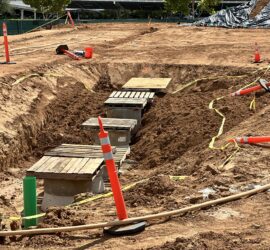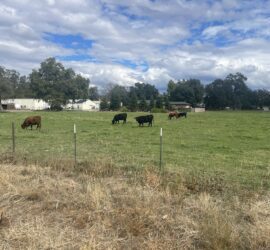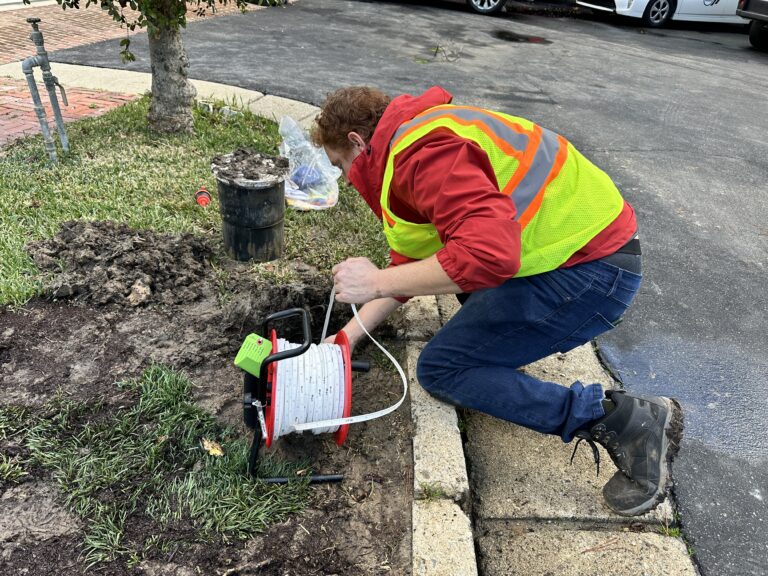Reporting Results of Environmental Due Diligence Investigation
“Are there requirements for reporting results of an Environmental Due Diligence Investigation to the government?” Each case is different. The answer is generally “no,” because ESA reports are typically proprietary. However, if there is any trace of danger or impact on the public’s health or well-being (in any way or form), the answer may be “yes.” This is a frequent inquiry by property owners and report users. Especially during real estate environmental due diligence periods with observable impacts. For example, when a Recognized Environmental Condition becomes apparent in a Phase 1 Environmental Site Assessment process, there is a potential for subsurface contamination to occur. Thus, a Phase 2 Environmental Site Assessment is necessary. Depending on the results, along with a few other facts, there might be an obligation to report the findings of an environmental due diligence investigation to an agency. Updated April 10, 2024.
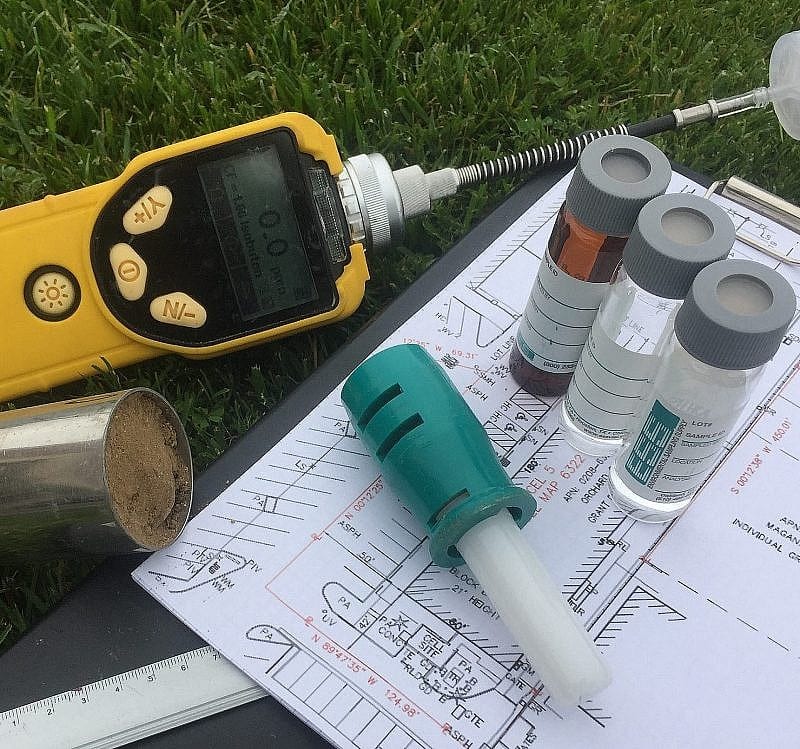
An article about Environmental Due Diligence by a California Professional Geologist.
Notice
This article was not written by an attorney. It does not intend to provide legal advice. This post simply serves to guide inquirers toward publically available supportive information using the engineering and geological professional standards in California. In all cases, Geo Forward advises readers to consult such matters with an attorney.
Do Environmental Site Assessment Results Need to be Reported?
In most cases, the requirement to report subsurface investigation results to government agencies generally depends on three factors of the job:
- Whether the results reveal any potential danger or risks to public health.
- If the job site is within a jurisdiction that requires agency permitting and data submission.
- Whether the purpose of the work intends to intercept known contamination or just test for it.
Reporting the Results of a Phase 1 ESA
In general, the information within a Phase 1 Environmental Site Assessment is proprietary. Depending on the terms and conditions of the agreement, all data and conclusions (whether written or verbal) are the proprietary information of the report user. Although users may choose to share the information with other parties themselves, consultants are generally obliged to report directly to their Client. However, it should be known by all parties that there is an absolute requirement to report the results of a Phase 1 ESA (as well as any other environmental report), if or when any danger to the public is discovered. For example, if a Phase 2 Environmental Site Assessment report reveals that a migrating vapor contamination plume is impacting the indoor air quality at a nearby school, the responsible parties may be legally required to report the findings to the local environmental agency or health department.
California Proposition 65 Warning
In California, Proposition 65 is the requirement for businesses and landowners to post warnings about significant chemical exposures that may cause cancer and reproductive system concerns. The source of the chemical does not matter. Whether from inside building materials, from within the subsurface, or in the air, there must be a warning. In fact, the Office of Environmental Health Hazard Assessment provides publications about the chemicals and products in association with Prop-65 warnings.
California Health & Safety Code
California Health & Safety Code 25359.4 indicates a person or entity must not release or allow for the release of reportable quantities of hazardous substances into the environment without agency authorization and/or permission. The code continues to define exceptions. And for those exceptions, it indicates that any release must be reported to the authorities within a 30-day timeframe from discovery.
Duty for Reporting Results of Environmental Due Diligence
Much like California Health & Safety Code 25359.4 and California Proposition 65, Federal guidelines and other State and local health code regulations similarly specify the obligation to report contamination that may be a risk to the public or environment. Most commercial real estate due diligence reports have the purpose of identifying whether a site is in (or out of) compliance with current environmental laws and regulations. Consequently, these matters do tend to arise during the property transaction due diligence periods.
Environmental Due Diligence & Public Health
Responsible Parties (or RPs) are typically the individuals or organizations responsible for a release. For instance, this can include property occupants, compliance violators and/or landowners. In the Phase 1 Environmental Site Assessment process, the environmental professional identifies each party, as well as their role to the property. And when necessary, the environmental professional will typically advise the appropriate parties to report the concerning findings of the environmental due diligence report.
Sensitive Receptors
Sensitive receptors are items that are considerably essential to society, and subject to impact. For example, water wells, schools, hospitals, and more. The distance and direction to the nearest sensitive receptor from a contamination case determines the risk of public danger. In fact, major sensitive receptors can be discussion points within a Phase I ESA or Phase II ESA report itself. Nonetheless, during environmental due diligence, property owners should refer to their environmental engineering consultant to determine whether a risk to public health exists or not.
Agency Involvement
If the results of a subsurface investigation show contamination impacting a sensitive receptor, there is a legal responsibility to recommend further action and report findings to the government. And various agencies have overlapping oversight on various sensitive receptors. For example, a threat to potable water resources is best applicable to the State Water Board. Similarly, a threat to indoor air quality due to soil contamination is best applicable to the State Department of Toxic Substance Control. Moreover, some contamination cases might also require involvement by local agencies, such as City Fire Departments, County Health Departments, and State Environmental Departments. Furthermore, federal involvement may be a requirement, depending on severity. As a result, the United States EPA may additionally require oversight.
Environmental Site Assessment Results
Reporting the results of an environmental due diligence investigation may not always be a requirement. Phase 2 Environmental Site Assessment reports compare onsite results with industry screening levels. And screening level numbers vary by location. In fact, some local, State and Federal advisories overlap in jurisdiction. Moreover, various agencies administer media-specific and land-use-specific screening levels. For instance, the Federal EPA has leading jurisdiction across the nation and publishes standards per region. Whereas State regulatory agencies may apply action levels inside their State boundaries only. In fact, some States (for example: California) have multiple divisions of their EPA, which also overlap each other. Furthermore, County and City agencies such as fire departments, health departments, and water agencies, also have overlapping jurisdiction above the State and Federal EPAs.
Screening Levels
Typically, screening levels are simply a reference point for reporting the results of an environmental due diligence assessment. In most cases, screening levels aren’t actionable levels. However, an environmental government agency can choose to use screening levels as an action level within its own oversight program. For example, a government environmental agency overseeing an ongoing remediation case may require the RP to clean up soil contamination until the contamination is below RSL screening levels.
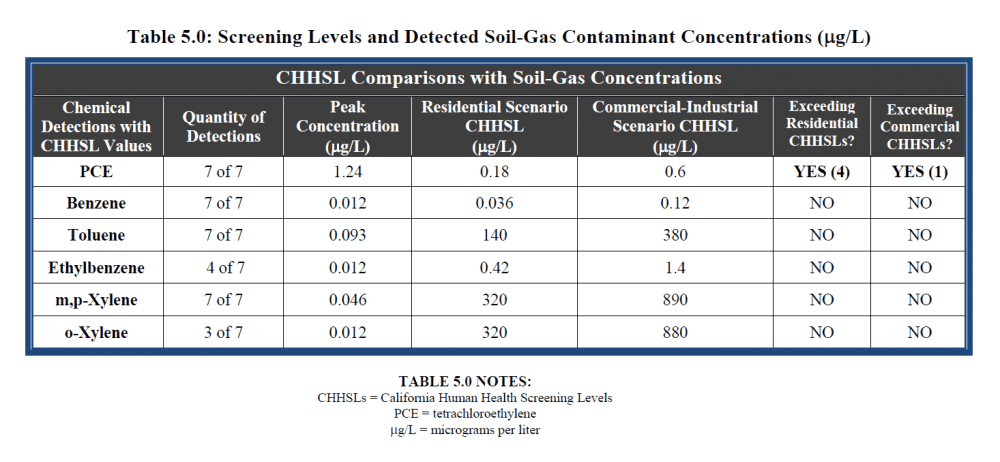
Various Screening Levels
The US EPA provides Regional Screening Levels (RSLs) which primarily apply for soil sample comparisons. Similarly, the California EPA provides Human Health Screening Levels (CHHSLs) for soil and soil gas. However, in the recent term (as of April of 2019), the leading soil-gas screening levels are now the DTSC HERO Note 3 Screening Levels. In fact, these publications provide a list of minimum chemical concentrations allowable for risk assessment purposes. Screening levels like these assist geologists and engineers when conducting toxicology and risk evaluation projects. In environmental due diligence investigations, screening levels are not typically associated with reporting limits. However, if health-threatening circumstances arise beyond a reasonable doubt, then reporting the results of an environmental due diligence investigation to a government agency may be apparent. This professional duty is a matter of public policy.
Actionable Groundwater Levels to Report Over
Unlike the abovementioned numbers, the Federal EPA also provides actionable Maximum Contaminant Levels (MCLs) as a drinking water standard. Consequently, Environmental Site Assessment work with groundwater testing utilizes MCLs as a basic guideline for risk assessment and reporting authority. Similarly, some local agencies establish their own screening and action levels for groundwater, basing on the research of the Federal EPA MCLs.
Reporting Results of a Phase II Environmental Site Assessment
A Phase II Environmental Site Assessment generally includes drilling for the analysis of soil, soil gas, and groundwater. However, these three media are not alike in terms of risk assessment and reporting obligations.
Additional Testing to Make Sure
A typical Phase 2 ESA report in California relates all onsite detections of soil and soil gas to screening levels. In most assessments, geologists and engineers also apply soil sample analytical data to geologic models to estimate risk. Some models focus on the extent of the contamination. Whereas other models focus on human exposure risks. Nonetheless, there is a professional and legal responsibility to recommend further action if the results of a Phase 2 Environmental Site Assessment suggest any of the following
- (1) the likelihood of contamination of groundwater near a potable source;
- (2) there is a potential health risk to the occupants of the lot by mode of vapor intrusion; or
- (3) any other possible human health dangers.
Jurisdictional Obligations
In some jurisdictions, exceeding screening levels alone can create an immediate obligation to report results. Some agencies also adopt the screening levels other larger agencies, to use as their own clean-up standards. This is typical during the course of remediation. Environmental engineering consultants and their clients should always contact the lead environmental agency for a site’s jurisdiction to confirm reporting obligations.
Sampling Groundwater in Phase 2 ESAs
Groundwater reporting requirements are held to a higher standard. Under the California EPA, the State Water Quality Control Board (SWRCB) protects groundwater on a statewide basis. In fact, the board is divisible into nine regions. Each regional board makes up the official “Regional Water Quality Control Board (RWQCB).” Each regional board provides oversight and interest in groundwater quality, with a focus on sensitive receptors. For instance, standards are higher for sites near a drinking water well, river, wash, school, hospital, etc. And in most cases, the RWQCB will act as the leading agency for oversight programs, alongside County and City agencies.
When Groundwater Detentions Exceed MCLs
If a Phase II ESA detects groundwater contamination that exceeds MCLs, the RP will likely need to report the data to their regional water board. Similarly, the same groundwater data may be a requirement for the County and City agencies, if a drilling permit is necessary. In most cases, agencies refer to MCLs as the minimum allowable contamination of groundwater before requiring notification.
Other Environmental Investigations
Some subsurface contamination investigations have a limiting scope of work, which differs from a Phase 2 Environmental Site Assessment. Nonetheless, the process of drilling to collect soil and groundwater samples from below the ground surface entails similar reporting obligations. Ultimately, it is important for all property owners and consultants to acknowledge each project is different. Variations exist in scope, purpose, jurisdiction, and result. And because reporting obligations can vary on a case-by-case basis, property owners should refrain from blindly relying on general information. Especially when undergoing real estate environmental due diligence periods. Instead, parties should consult with their environmental engineer, attorney, and local regulatory agency.
Drilling Permits
Some County and City environmental agencies will also require a borehole permit for any drilling project within their jurisdiction. On the other hand, some agencies only require a permit when groundwater is present. Often times these permits have a closure process that requires reporting all the laboratory data, regardless of the result. Consumers can rely on their environmental engineering consultants to provide such information. If so, consumers must prepare to release analytical data to the respective government agency, no matter what the result.
Ongoing Remediation Cases
A responsible party may also need to report analytical data from a subsurface investigation if the site is already undergoing regulatory oversight for remediation. Under these circumstances, the lead agency caseworker will directly require a copy of the assessment report to review and publish as municipal information. Prior to any subsurface testing, a Phase I ESA report discloses whether the property is undergoing regulatory oversight or not. In the State of California, assessment reports for properties with known groundwater and soil contamination cases are visible via the SWRCB Geotrackter Database. Similarly, reports for properties with known soil and soil-gas contamination cases are available via the DTSC Envirostore Database.
For more information or a free consultation about site-specific environmental due diligence reporting requirements, call (888) 930-6604.
California Health and Safety Code, Section 25359.4:
Section A
(a) A person shall not release, or allow, or cause a release of, a reportable quantity of a hazardous substance into the environment that is not authorized or permitted pursuant to state law.
Section B
(b) Any release of a reportable quantity of hazardous substance shall be reported to the department in writing within 30 days of discovery unless any of the following apply:
- (1) The release is permitted or in the permit process.
- (2) The release is authorized by state law.
- (3) The release requires immediate reporting to the Office of Emergency Services pursuant to Section 11002 or 11004 of Title 42 of the United States Code, or pursuant to Section 25507.
- (4) The release has previously been reported to the department or the Office of Emergency Services.
- (5) The release occurred prior to January 1, 1994.
Section C
(c) For the purposes of this section, “reportable quantity” means either of the following:
- (1) The quantity of a hazardous substance established in Part 302 (commencing with Section 302.1) of Title 40 of the Code of Federal Regulations, the release of which requires notification pursuant to that part.
- (2) Any quantity of a hazardous substance that is not reportable pursuant to paragraph (1), but that may pose a significant threat to public health and safety or to the environment. The department may establish guidelines for determining which releases are reportable under this paragraph.
Section D
(d) The owner of the property on which a reportable release has occurred and any person who releases, or causes a reportable release and who fails to make the written report required by subdivision (b), shall be liable for a penalty not to exceed twenty-five thousand dollars ($25,000) for each separate violation and for each day that a violation continues. Each day on which the released hazardous substance remains is a separate violation unless the person has either filed the report or is in compliance with an order issued by a local, state, or federal agency with regard to the release.
Section E
(e) Liability under this section may be imposed in a civil action or may be administratively imposed by the department pursuant to Section 25359.3.
Section F
(f) If the violation of subdivision (b) results in, or significantly contributes to, an emergency, including, but not limited to, a fire, to which a county, city, or district is required to respond, the responsible party may be assessed the full cost of the emergency response by the city, county, or district.”
Additional Information:
DTSC Reporting Nonemergency Hazardous Substance Releases




